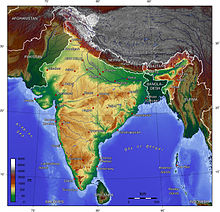India, the major portion of the Indian subcontinent, lies atop the Indian tectonic plate, a minor plate within the Indo-Australian Plate. India's defining geological processes commenced seventy-five million years ago, when the Indian subcontinent, then part of the southern supercontinent Gondwana, began a northeastwards drift—lasting fifty million years—across the then unformed Indian Ocean. The subcontinent's subsequent collision with the Eurasian Plate and subduction under it, gave rise to the Himalayas, the planet's highest mountains, which now abut India in the north and the north-east. In the former seabed immediately south of the emerging Himalayas, plate movement created a vast trough, which, having gradually been filled with river-borne sediment, now forms the Indo-Gangetic Plain. To the west of this plain, and cut off from it by the Aravalli Range, lies the Thar Desert.
The original Indian plate now survives as peninsular India, the oldest and geologically most stable part of India, and extends as far north as the Satpura and Vindhya ranges in central India. These parallel ranges run from the Arabian Sea coast in Gujarat in the west to the coal-rich Chota Nagpur Plateau in Jharkhand in the east. To their south, the remaining peninsular landmass, the Deccan Plateau, is flanked on the left and right by the coastal ranges, Western Ghats and Eastern Ghatsrespectively; the plateau contains the oldest rock formations in India, some over one billion years old. Constituted in such fashion, India lies to the north of the equator between 6°44' and 35°30' north latitude and 68°7' and 97°25' east longitude.
India's coast is 7,517 kilometres (4,700 mi) long; of this distance, 5,423 kilometres (3,400 mi) belong to peninsular India, and 2,094 kilometres (1,300 mi) to the Andaman, Nicobar, and Lakshadweep Islands. According to the Indian naval hydrographic charts, the mainland coast consists of the following: 43% sandy beaches, 11% rocky coast including cliffs, and 46% mudflats or marshy coast.
Major Himalayan-origin rivers that substantially flow through India include the Ganges (Ganga) and the Brahmaputra, both of which drain into the Bay of Bengal.Important tributaries of the Ganges include the Yamuna and the Kosi; the latter's extremely low gradient causes disastrous floods every year. Major peninsular rivers, whose steeper gradients prevent their waters from flooding, include the Godavari, the Mahanadi, the Kaveri, and the Krishna, which also drain into the Bay of Bengal;and the Narmada and the Tapti, which drain into the Arabian Sea. Among notable coastal features of India are the marshy Rann of Kutch in western India, and the alluvial Sundarbans delta, which India shares with Bangladesh. India has two archipelagos: the Lakshadweep, coral atolls off India's south-western coast; and theAndaman and Nicobar Islands, a volcanic chain in the Andaman Sea.
Climate
India's climate is strongly influenced by the Himalayas and the Thar Desert, both of which drive the monsoons. The Himalayas prevent cold Central Asian katabatic winds from blowing in, keeping the bulk of the Indian subcontinent warmer than most locations at similar latitudes. The Thar Desert plays a crucial role in attracting the moisture-laden southwest summer monsoon winds that, between June and October, provide the majority of India's rainfall. Four major climatic groupings predominate in India: tropical wet, tropical dry, subtropical humid, and montane.
Biodiversity
Lying within the Indomalaya ecozone, with three hotspots located within its area, India displays significant biodiversity. As one of the seventeen megadiverse countries, it is home to 7.6% of all mammalian, 12.6% of all avian, 6.2% of all reptilian, 4.4% of all amphibian, 11.7% of all fish, and 6.0% of all flowering plant species. Manyecoregions, such as the shola forests, exhibit extremely high rates of endemism; overall, 33% of Indian plant species are endemic.
India's forest cover ranges from the tropical rainforest of the Andaman Islands, Western Ghats, and northeastern India to the coniferous forest of the Himalaya. Between these extremes lie the sal-dominated moist deciduous forest of eastern India; the teak-dominated dry deciduous forest of central and southern India; and the babul-dominated thorn forest of the central Deccan and western Gangetic plain. Important Indian trees include the medicinal neem, widely used in rural Indian herbal remedies. The pipal fig tree, shown on the seals of Mohenjo-daro, shaded Gautama Buddha as he sought enlightenment. According to latest report, less than 12% of India's landmass is covered by dense forests.
Many Indian species are descendants of taxa originating in Gondwana, from which the Indian plate separated a long time ago. Peninsular India's subsequent movement towards, and collision with, the Laurasian landmass set off a mass exchange of species. However, volcanism and climatic changes 20 million years ago caused the extinction of many endemic Indian forms. Soon thereafter, mammals entered India from Asia through two zoogeographical passes on either side of the emerging Himalaya. Consequently, among Indian species, only 12.6% of mammals and 4.5% of birds are endemic, contrasting with 45.8% of reptiles and 55.8% of amphibians. Notable endemics are the Nilgiri leaf monkey and the brown and carmine Beddome's toad of the Western Ghats. India contains 172, or 2.9%, of IUCN-designated threatened species. These include the Asiatic Lion, the Bengal Tiger, and the Indian white-rumped vulture, which suffered a near-extinction from ingesting the carrion of diclofenac-treated cattle.
In recent decades, human encroachment has posed a threat to India's wildlife; in response, the system of national parks and protected areas, first established in 1935, was substantially expanded. In 1972, India enacted the Wildlife Protection Act and Project Tiger to safeguard crucial habitat; in addition, the Forest Conservation Act was enacted in 1980. Along with more than five hundred wildlife sanctuaries, India hosts thirteen biosphere reserves, four of which are part of the World Network of Biosphere Reserves; twenty-five wetlands are registered under the Ramsar Convention.



No comments:
Post a Comment